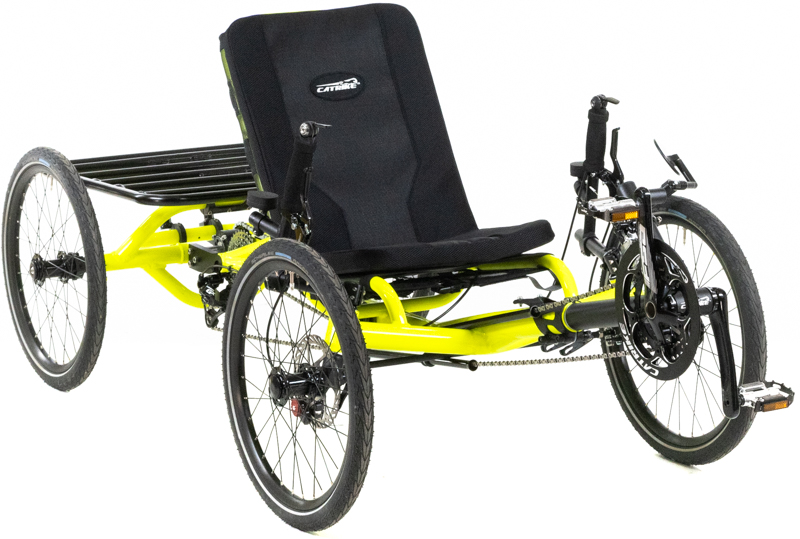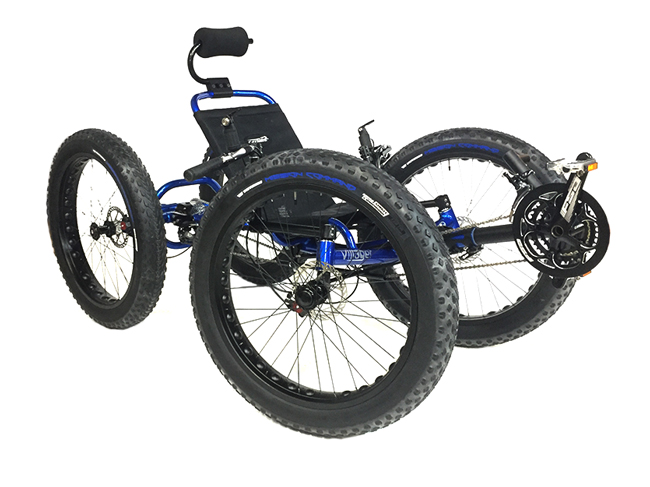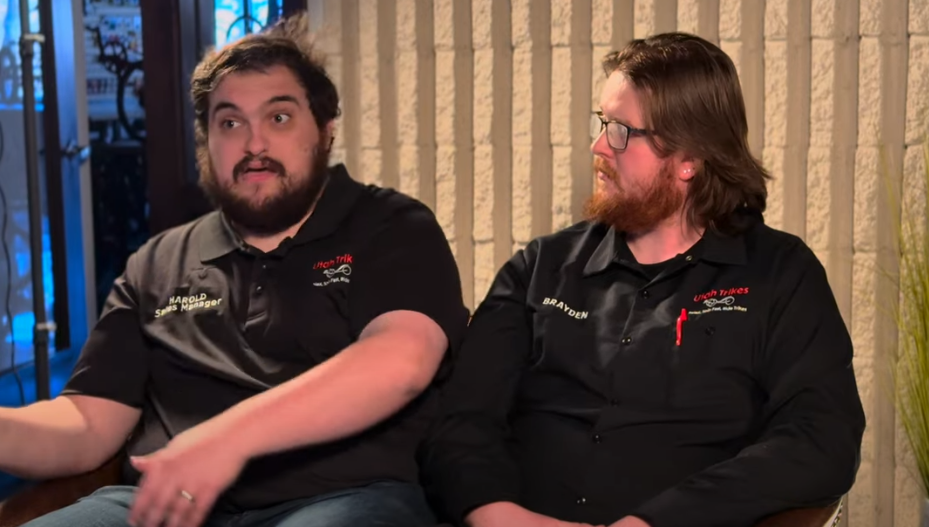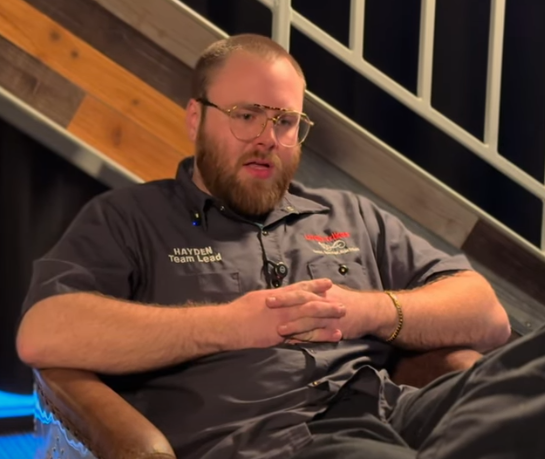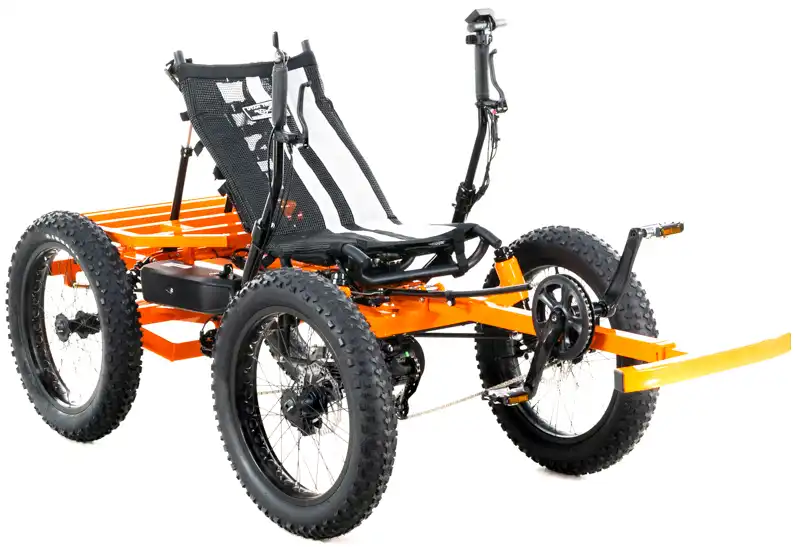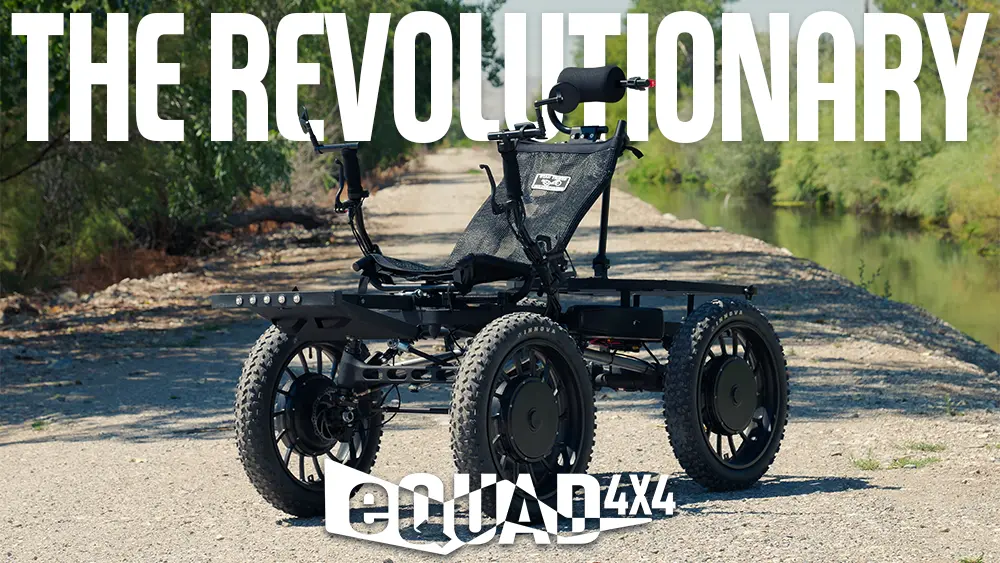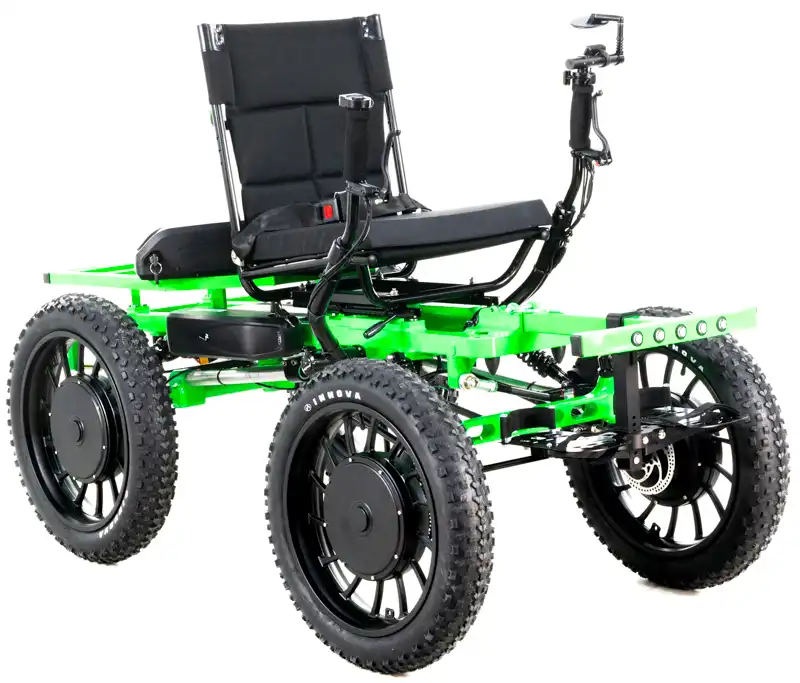
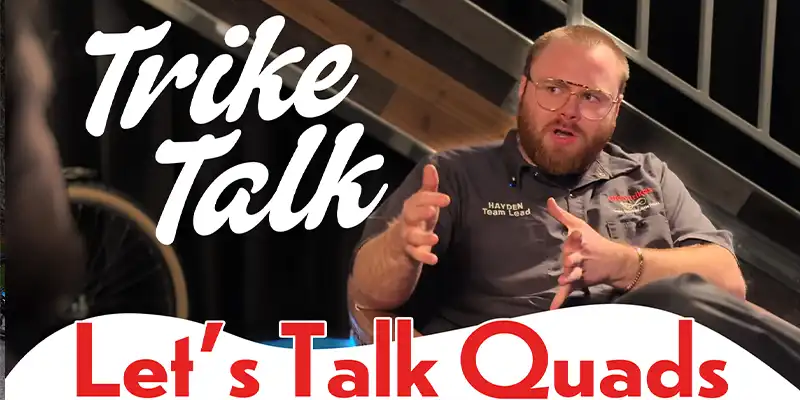
Trike Talk- Ep 7- Quad Conversions, Electric Quads & Four-Wheel-Drive eQuads!
Published on 04/01/2025
Harold: Hi everyone, I'm Harold.
Brayden: And I'm Brayden.
Harold: And we're here to talk trikes!
Hayden: ...and quads too.
Brayden: And this is a special episode. A lot of what we do down here at Utah Trikes is build quads, either quad conversions or full custom builds. We've got the guy for it, so like we said, this is a special episode. We have our team lead, Hayden, here with us.
Hayden: So, I'm the team lead of the Quad Department here at Utah Trikes. That's a big part of what we do here. We manufacture quads, notawheelchairs, and we also have our own eQuad. We do all the design, the welding, the fabrication-all done in-house. A big part of my job is just keeping everybody busy, keeping an eye on everybody, making sure we've got all our production going smoothly, getting our pre-assemblies done before we jump into a build. There's a lot of pre-assembly to do.
Harold: You also take care of some of the quality assurance on the quads, right? Towards the end?
Hayden: Yeah, so when the guys are finished building, they'll give it to me, and I'll run through it and do a quality check on it.
Brayden: Just to interject, I mean, you QA right after they're built, but it doesn't stop there. I mean, if the customer has problems, you're typically the person I'm going to hand them to. You're the most knowledgeable. You're always ready to help them.
Hayden: Yeah, doing customer service, you know.
Harold: We might be called Utah Trikes, guys, but little-known fact: we've been building quads for about 18 years. That started out with trike-to-quad conversions. That's where we take any number of trikes that we have here, we custom fabricate brackets, the rear ends, and turn them into a quad. Now, the question for you guys is: why would someone want to get a quad over a trike?
Harold: We get that all the time where people are like, "I have to go commute to the grocery store for one reason or another. I can't use a car anymore, and I need something to commute with." Those are a great option to take-h, any of the trikes we have, well, most of the trikes we have here, and we'll get into that, and even any trikes that you might have. If you're brave, you can do the conversion yourself and be able to make yourself a little commuter.
Brayden: And higher weight capacity, stability... Any downsides you think? Of, I mean, right off the bat, I come to like transporting a quad.
Hayden: Yeah, that is true.
Brayden: I mean, these are bigger.
Hayden: It's a bigger footprint, that's for sure.
Brayden: Is there any more maintenance involved with the quad than you would with a trike? Any argument to be made there?
Hayden: Uh, not too bad. Just adds an axle with a differential in there, and that's just something that you just want to make sure that, uh, bearings aren't getting real dirty and dry, and all the set screws that are securing everything on the axle are...
Brayden: We've been doing this for a long time, so I mean, hopefully we've come up with some pretty bulletproof designs.
Hayden: Yeah, it's pretty good.
Harold: The bulk—other than the custom components we make here, like pixels and everything—would you say that the bulk of what goes into a quad are parts that someone could find in a bike shop if they needed to get a quick replacement? What I'm talking about is like the chain...
Hayden: Yeah, yeah, when it comes—so a lot of it is just, especially like the chains, yeah, it's a lot of, uh, bike parts, and the brakes are all bike parts. We do do a lot of custom parts, though, for our conversions and the quads themselves. Like, we make our own sprockets and sprocket mounts and axles and things. But it is nice because a lot of the—a lot of the stuff that needs to be maintained or replaced is, uh, kind of just general bike parts. There's an opportunity to be able to do what you want and kind of customize it with different parts that are just—whether brakes or chains or sprockets.
Harold: Right, yeah. We make our quads all modular here, so like, any of the trikes that we have here—you guys already know how custom they can be—it's the same story, if not more, with our trike-to-quad conversions and, of course, our eQuads as well.
Brayden: We keep talking about trike-to-quad conversions, and you mentioned we have a couple kits made for specific models of trikes. What trike models can we convert to a quad? I mean, at this time, we have kits for them. We can do it. What are those?
Harold: Those are going to be all of the Catrike models. Um, those are all going to have a quad conversion kit. And then also, correct me if I'm wrong, I think the Eco Tad is the only other model outside of Catrike that we offer a quad conversion kit to as well. Those are just some of the most popular trikes that we have and that we've been working at for this long time. Those are quad conversions that we've been able to make and feel the most comfortable with working on.
Hayden: Mhm, yeah. We have—so we have a lot of—there's a lot of trike models that we can convert to, uh, quads. The only models that we do not do quad conversions are rear-suspension quads. Um, so that being like the Catrike Dumont or a lot of the European trike models that have rear suspension. It just doesn't—we're just not doing that at the time.
Brayden: Had pretty mixed results. I mean, we've done it, but I wouldn't...
Hayden: And we've done—and we've done lots of one-off quads for just custom things for customers that have come to us. And so we've made it work on many different things. We've had better success than others—than other times. So we've kind of used that feedback and that experience from doing these custom things to really hone it in and be like, "These are the models we want—what works really well." Yeah.
Brayden: You mentioned earlier the custom differential we had made for these quads. It took us a long time trying a lot of things out. A lot of things that existed already simply wouldn't work for the purpose we were trying to use.
Hayden: It's too light, or the bike was too—or the quad was too light, or the differential, like, wasn't strong enough, so it would break on us.
Brayden: Yeah, pushing too much torque and power through it. So we're either breaking the differential—quad rear end doesn't weigh enough, so you'd spin out all the time. Yeah, so interesting about our custom differential, right? If the whole thing picks up and loses traction, it kind of acts as a through axle. Yeah, so you don't lose that traction. At least, the wheels keep spinning.
Hayden: Yeah, it doesn't prevent it from really slipping, especially when you—when you need it the most. And, uh, we have—we do have some quads that are solid axles, and we have some that are differential as well. Um, the difference being—like, with a—with the differential—um, it doesn't have the ability to go in reverse, which some people would like with their quads, especially if we use a hub motor in the quads. They're able to go in reverse. But if you have that differential back there, it'll just free-will spin. Um, so some—we have solid axles.
Brayden: Because I know people are going to ask, I mean, when you're on the quad, you're riding it around, what's going to be the feel? I mean, what's going to feel different about a solid axle and a differential?
Hayden: That just limits the turning radius a little bit.
Harold: And that's going to be like the "not a wheelchair" quads that are solid in the rear.
Hayden: Yeah, mainly just the turning radius. Like, it would be hard to tell if you hadn't ridden both. Uh, but yeah, you just kind of feel—you just will feel yourself not being able to turn as sharp as all that's really all.
Brayden: I mean, both wheels are spinning evenly, I assume, with a solid axle, right? So if you're going to turn on an angle that's sharp, this wheel's got to turn a lot slower now than the outside wheel. A solid axle is not going to let you do that.
Hayden: Mhm. And with the solid axle versus differential, the biggest thing is the tires. Most of the quads we build have fat knobby tires on them intended for off-road. So, what a lot of customers might experience is if you're riding a lot on pavement with the knobby tires, that's the biggest thing you're going to feel versus a solid axle differential. That's to the side when, really, you're going to feel the tires, 'cause those knobby tires, like, if you're riding on pavement a lot, you're going to notice the wear on the tires are going to wear out a lot faster than if you're just riding off-road how they're intended. So, that's a big thing to watch out for is to think about what kind of riding you're going to be doing and choosing the right kind of tire.
Brayden: And we're talking—me and him are at least talking to customers all the time, right? During that purchasing process, one of the big things that is immediate is, "Hey, are you going to be riding this off-road? Are you going to be taking it on the road?" A lot of that is the tire wear, 'cause I know 3-6 months from now, you're going to call me and say, "These tires are worn off. What's wrong with them?"
Hayden: And I've talked to people…
Brayden: I know you have. That's why I'm bringing it up.
Hayden: I say, "Do you ride it? Do you ride it off-road?" And they're like, "No, I almost exclusively ride on the street." It's like, "Let's get you some street tires."
Brayden: Yeah, you need tires that don't sink into the concrete. They're trying to rip themselves apart.
Hayden: Yeah, exactly.
Harold: Well, Hayden, you mentioned some pretty specific use cases with the solid axle. Mainly, we use those on our NAWCs with the Hub motor so you can reverse. What are some other use cases for having a solid axle on a quad?
Hayden: Yeah, so lately we've been doing a lot of testing with different motors and gearing that we're pretty excited about. So, in our experience from testing out these different motors and different gearing on it, we've tried a mid-drive motor, and we've been testing the Enviolo automatic for the automatic shifting. And really, with the solid axle, yes, we have the "not a wheelchair," and like the main reason is so that the reverse works with the hub motor. But really, like, if you're doing most of your riding off-road, a solid axle is kind of the way to go, 'cause you just know that you have both wheels always going at all times. Really, you really only notice it the most as if you're trying to make a sharp turn in a parking lot or something with the knobby tires, and you can just really feel them fighting against you. But really, yeah, like, and most people here would agree too that we would rather go for a solid axle if you're doing just all off-roading. That being said, like, all of the quads that we have currently, except for the "not a wheelchair," all have a differential for right now—for right now at least. But yeah, we're doing a lot of testing right now that we're excited about, and we've been having some fun riding out these new quads we've been building.
Harold: A little bit later.
Brayden: Yeah, we're excited to get into it.
Harold: Oh, yes, we are.
Brayden: Let's talk about motors a little bit. A lot of our eQuads, you know, electric eQuads, they come with motors. Do they have to? Do we offer quads that don't come with motors?
Hayden: Yeah, yeah. So, the eQuad, that's our platform, and those all have motors. They're pedal motor hybrids, and those all use a 1,000-watt mid-drive motor. Sure. Now, with the Cat 4 conversions, you can get those without the motor. Uh, 90% of the ones we make do we put the mid-drive motor on the front. It's more weight, bigger tires. With the "not a wheelchairs," we use a watt hub motor. And then we also have our new 4x4 eQuad that has 1,700-watt motors in each wheel. So, that's four 1,700-watt motors, so you could imagine how much more power those have. Right now, we're kind of playing with the idea of doing two-wheel drive. We just came up with a 2x2, so it was two wheels or a pedal and then the hub motor. So yeah, it's pretty interesting what you can play with, and they kind of have different pros and cons. Like, the mid-drives, they can go—they usually can go a little bit faster. They don't have reverse, however. But like all the hub motors and our 4x4 platforms, those have reverse. Quad conversion with a trike versus our eQuad—people go for these because it's like, it's kind of a car replacement for a lot of people. Like, they can have a rack on the back where they can have a lot of cargo. With the eQuad, it has quite a bit bigger clearance—ground clearance on it as compared to the trike conversion. So, that's another big reason why people…
Harold: Yeah, easier to take in all these other off-road or semi off-road places.
Brayden: Even worth arguing, right? The seat height's a lot higher. I mean, getting in and out of a quad's a lot easier than getting out of a trike generally, right? Of course, the Catrikes, I mean, were pretty similar, but specifically with our eQuad model, that's a pretty tall seat.
Harold: Yeah, that sits at like 22”.
Brayden: I mean, really the cool thing about the eQuad—I mean, it's our frame. This is our design, right? So, we're pretty modular here. I mean, allowed to customize it. We are—we are doing things to it.
Hayden: Yeah, exactly. Yeah, and we're always getting—we're getting good feedback, and we take that into consideration. We kind of, as we go, we really fine-tune stuff.
Brayden: We've been improving the platform forever now. Yeah, there's always improvements, getting better. We have new things coming out soon. Yeah, very excited about it. I mean, I just wanted—I know we were holding off. I made it to get to it—the automatic eQuad that we have in the works. Yeah, oh my gosh, fantastic!
Hayden: It's really cool. We've been—that's like been the biggest thing we've been excited about. Yeah, it's been a lot—it's been a lot of fun. It's a hub transmission that automatically shifts, and so it has no pedals. We have a mid-drive motor hooked up to it—we've been playing around with different sprockets so that we could really, 'cause what we really want to get is like the lowest gearing possible, so it's just really, you just feel really confident in its climbing ability. And as it is now, like, it's been doing really well, but we can still—we're still kind of playing with…
Brayden: These are teasers. I mean, we're not—I'm not saying this is coming out soon.
Hayden: Yeah, that's something that we're pretty excited about for sure. We've been having a lot of fun. You can tell by everybody's reactions to riding it around the shop. Everybody's loving it.
Harold: We even had our shop owner, Ashley, he's been ripping around. I think he's just been doing that for fun though.
Hayden: Yeah, Ashley's been having some fun with it. We're also—we're also used to test writing these things that it's like when you have something that people are getting excited about, it's like…
Harold: It's nice to feel…
Hayden: I think we're on to something. Yeah.
Harold: So, Hayden, you said that this comes without pedals. Is this how it's always going to be with this updated platform?
Hayden: We can absolutely put pedals on it. It's all customizable. So, coming soon here on the configurator, you'll be able to choose whether you want pedals or not. It's all modular like that, so we're really excited—excited because it just gives a lot of options to really figure out what you want.
Harold: The quad of your dreams, perhaps?
Hayden: And what kind of riding you'll be doing. And we've really dialed—we think we've dialed in the gearing how we like it. So, yeah, it'll just really be up to what kind of riding you like to do. Yeah, for sure. You can really customize it to how you want. And so, you can—it could really be a pedal quad, like a recumbent eQuad where you're pedaling around, or it could even be like an off-road wheelchair-type device where, even if you don't want to pedal, you can just get around and go get groceries or go off-road or do whatever else.
Harold: Getting more into that commuting or adventuring, we really want our eQuad platform to be the platform that's the best for you, no matter what it may be. The word of the day has been "eQuad platform." Can you dive a little bit into what we mean by that?
Hayden: Yeah, yeah, for sure. So, really, it's a true platform in the sense that we have a lot of standardization going with how we attach things to the frame. We have multiple different rear ends that are all compatible and all bolt on the same way to the frame, whether it be a welded—a welded rear end with a differential or the other rear end that has the solid axle. And then, we've also been working on a rear end that attaches the same way that has two hub motors in the back. So, that's one way. And then, also, the way we attach the batteries to the frame, the way we attach the rack, it's all really—we've made slight tweaks and improvements over time, but really, it's all standardized in the same way we mount everything. So, it's really—and the front is as well. So, depending on if you want pedals or not, you can just swap a different boom out, and it just slots right in. And, same with the spindles or the motor as well. We can attach a mid-drive motor to it or a hub motor. Yeah, and seats as well. We have multiple different mounting options for seats. We have the upright seat and the recumbent seat, and it's just really there so that, over time, if you wanted to, you could really build off of it.
Brayden: And what I thought was really cool—right? I think of them as like truck models. Having five different trucks all built five different ways. We have one frame, yeah, and we throw a different body on it.
Hayden: Yeah, build off.
Brayden: You can switch, right? I mean, not that it's necessarily the easiest thing to do, but we can—we've been modifying it.
Hayden: Yeah, and with the same frame, you can have a lot of different riding options and different gearing, whatever. There's a lot of different customization and configuration you can do with them.
Harold: We see it often enough with emails and calls from people who are really excited about the eQuad platform—so excited that they've actually customized it on their own. I've had customers who have taken bucket seats from race cars and bolted those down to the eQuad, huge cargo containers and putting those on the back as well. Really, we want this platform—even with what we can do—we want it to be yours too, to personalize it to however you want to ride it, whatever makes you comfortable. Solar panels as well, trailers, whatever. It's yours. Love it! We love it too, and we love to see what you guys are making with our builds.
Hayden: Yeah, for sure. That's kind of—that's kind of the hope and idea with it—that people will take it and customize it and do what they really want with it. Yeah, it's kind of a...
Harold: I'm still waiting for the jet liner eQuad version. Haven't seen that yet, so that's the next challenge.
Brayden: Make one take flight.
Harold: Yeah, helicopter eQuad.
Brayden: So, Hayden, we keep talking about the eQuad platform. The way I understand it, we had to redesign and make a new platform for the 4x4 specifically.
Hayden: Yeah, so with the 4x4, we really wanted to get four high-powered motors onto it so that it's our fastest—it's our fastest quad, it's our most capable, it's most powerful. With that though, we really wanted to improve the suspension in the front specifically. So, we really had to do a big redesign with the front for the 4x4. With that said, you now have two shocks in the front that you're basically sitting on, so that gives you like 3 to 4 inches of vertical travel, which is a really big improvement over...
Brayden: I think the standard eQuad was an inch and a quarter.
Hayden: Yeah, yeah, just in the spindles too. So, with the 4x4, you can really fine-tune the shocks as well. You can tighten them, you could put different—you could put heavier rated coils on them even if you wanted to, if you wanted a stiffer ride. So, you can really—how your weight is—you can really fine-tune it and get it to be as soft as possible or just get it to be really rigid.
Harold: Perfect ride.
Hayden: Yeah. And there's a lot more articulation too with the front wheels as well. So, just off-roading and climbing, it's just a lot better—better than what we have now.
Harold: But this new platform for the 4x4—are we only using that for the 4x4, or are we going to be using that for new builds coming? Yes.
Hayden:Yeah, so we actually have a new system, a 2x2 quad. So, the front wheels will be hub motors in the front, but then in the rear, it'll be our standard eQuad pedal gearing. So, the rear wheels will be pedal-powered by the rider, and then the front wheels—so it'll be a hybrid of pedal versus electric power. But this—but then that gives you the 4x4 platform. So, that gives you—exactly, yeah—that gives you a lot better vertical travel and articulation with the front end.
Brayden: Pedal assist, right? It's using that mid-drive motor. So...
Hayden: No, so it's just—so just the rear wheels are full pedal power, and then the front wheels have the motors in them. So, there's no mid-drive on this one.
Brayden: Oh, really? Oh, okay. I'm following.
Hayden: So, yeah, you can really—you could pedal it around just on your own, just by your legs, and then you can use the front two hub motors to get you around if you need to.
Harold: What sort of max speed are we going to be looking for on this 2x2 we're making?
Hayden: On the 2x2, yeah, we have—in our hub motors for our 4x4s, we have two different versions. One version, the top speed is 30 miles an hour, so that one goes the fastest—a 30 mph wheel, which is pretty crazy. It's a lot of fun.
Brayden: Yeah, that's great—only 30s.
Hayden: But the way hub motors work—so like, the higher the RPM of the wheel, there's a trade-off with how much torque you're going to get. So, the second version is a 20 mph wheel, but then you get increased torque with it. So, we're thinking, with off-roading and climbing big hills, it should help a lot. And so, we're thinking with the 2x2, the front wheels on that will be the 20 mph wheels, because we would want that increased torque. And really, like, you're not going to be pedaling that thing—or you want to make sure you're getting help while you're pedaling uphill. You would definitely think the more torque, the better on that. So, and that'll be two different options that we can choose from too, depending on what people want—if they want to be able to get up to 30 mph if they're commuting, or they're just doing more off-road stuff. It just depends.
Brayden: Kind of leads back to what I said earlier. I mean, very modular. This is our platform
Hayden: Yeah, totally. There are no limitations, really.
Harold: Right, Brayden and I have a whole show where we talk about trikes and pretty much only trikes with the occasional quad reference here and there. You are on the ground working on these quads all week. Can you tell me why you love quads?
Hayden: Yeah, for sure. So, really, compared to the trikes, um, we've mentioned this, but they have a lot more ground clearance. Um, and then also, with the four wheels, you don't have three tracks going behind you, so if you're going off-road, you don't really have to worry about that as much. You can really straddle things and get over the top of a lot of stuff easier. That's probably the biggest thing I like—just being more upright and being on top of things.
Brayden: That extra wheel gives you a lot more traction. I—it can't be understated how much these wheels are grabbing that ground.
Hayden: Yeah, you have a whole other wheel now that's really giving you a lot of extra traction, and that's—yeah, you can't understate that, for sure, especially going off-road, um, which is what we like to do the most.
Brayden: You keep saying "off-road, off-road, off-road, off-road," and that's not necessarily their only use, but I do think they excel in off-road travel, sure. And also, another thing that's really great about them is the rear end. You can put racks on them and really customize them, so you can really fit a lot of stuff back there if you want. That's—I like that a lot—putting big cargo containers or whatever else back there.
Harold: We have a huge outdoor camping culture here in Utah, and that eQuad is kind of just an example of the culture that we have here—being able to be modular and being able to go outdoors and take what you want and go camping, go out and really enjoy nature.
Hayden: Yeah, for sure. And there are definitely still trade-offs between, uh, the eQuad and then, like, a quad conversion with the trike. Obviously, with the eQuads, they're quite a bit bigger. They're going to take up more space, so you have to think about being able to transport them or whatever else. You can't—we don't have any folding eQuads. You can't fold them up and shove them in a corner.
Harold: There's no folding quads?!?
Brayden: Hayden, real quick, how would you fold that quad if you could? Just, you know, ergonomically? Yeah, with a saw? Cut it into pieces?
Hayden: Cut it in half.
Brayden: You would have to disassemble. I mean, if you're trying to make them smaller, disassembly is the only way.
Hayden: Yeah, they're obviously—they're more—especially with the 4x4. So, our version of the 4x4 that goes 30 miles an hour needs four batteries on it to be running, so that, in itself, adds a lot of weight, including all the hub motors that are on it. So, they're going to be quite a bit heavier than a quad conversion from a trike. Um, yeah, that's—that's the biggest thing—clearance. Um, I like that a lot and, like, just the traction, really.
Brayden: Off-road, yeah, they're off-road monsters.
Hayden: Being able to transport stuff.
Harold: Right, for transporting these things, you're not left high and dry, right? We have the e-bike racks now, and those can take these eQuads, even the 4x4s, and take those with you on the hitch receiver on the back of a truck or car.
Brayden: Well, I mean, we're talking about trucks, right? I mean, it's not the only solution, but we've gotten them to fit in the bigger trucks all the time. I mean, they're heavy, sure. We do it all the time. Not to mention, if you wanted to get a trailer.
Hayden: Get yourself a little trailer for it. We see that all the time. Really, with the eQuad, it's big enough that you're not going to be able to fit it in the back of a minivan or SUV or something like that, um, which a lot of people with trikes or even the quad conversions will be able to fit in their little SUV or something like that. But it's just that the eQuad platform is just too big to be able to fit inside of a car, from our experience.
Brayden: I—I think that's more than fair to say.
Harold: Yeah, hey, I can feel your excitement just in generally talking about these quads. What are you excited for the most that's coming up or that you're working on currently?
Hayden: Yeah, so right now we have been working on a few new things, uh, which has been really fun. That's my favorite part, um, is kind of prototyping stuff and figuring it out and, uh, figuring out the gearing and stuff. But really, we've talked about it before, but the automatic shifting, uh, quad, uh, using the Enviolo hub, has got me the most excited recently. Yeah, it's really fun. I like—um, I like hearing the transmission shifting as you're riding. Yeah, and it's just—I've been building, uh, "not a wheelchairs" for a few years at this point, and so having something like that, it's very similar, but, but, uh, it just seems to be more fun to ride.
Harold: Fun and more innovative.
Hayden: Yeah, totally. So, yeah, just really just kind of innovating and just really making tweaks and taking feedback.
Brayden: And I'm glad you saw that. I mean, we're all right around that automatic eQuad, and the whole quad team's, you know, brighter—everything's happier. We come back there, like, "Hey, this thing's awesome!"
Hayden: Yeah, we like—yeah, it's really fun to be like, "Okay, we—we do these. We build these things every day. We have our bread and butter, whatever. But then when we have, 'Okay, let's start coming up with something new. Yeah, let's innovate.'"
Harold: I can see all you guys beaming.
Hayden: It's—yeah, you have a lot of fun doing that.
Harold: Your excitement makes us all excited here.
Hayden: It rubs off.
Harold: Yeah, Hayden, we've been talking about all these new developments that we're working on. We're very excited about everything. When do you think these are all going to be released?
Hayden: Yeah, so it's my understanding that within the next week or two, we're going to be doing some spotlight videos and getting our configurators on the website figured out. So, yeah, really within the next week or two, just keep an eye out, and we should be announcing what we've been working on.
Harold: Well, Hayden, thank you so much for taking time out of your busy day from working on quads and talking with us a little bit here on the trike show.





